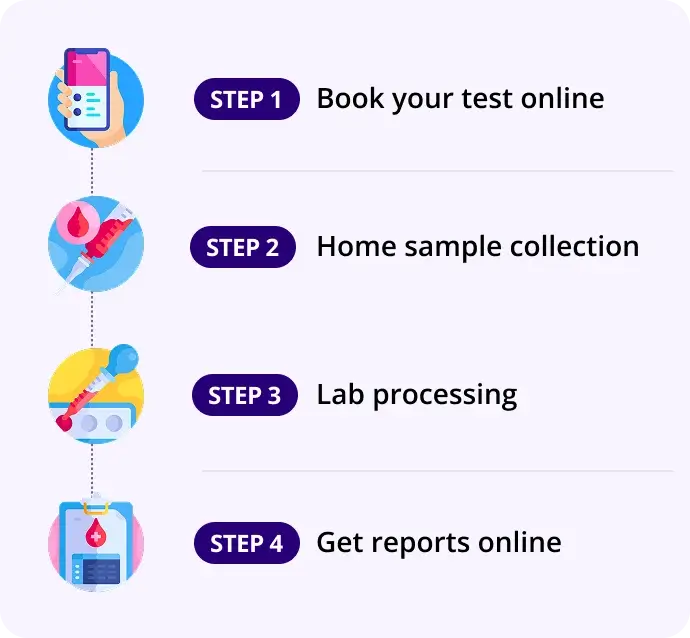Appendix -Large Biopsy 3-6 cm
Unit Test
Report in 288Hrs
At Home
No Fasting Required
Details
For appendicitis, tumors, or mass lesions, mucinous lesions, abdominal pain
₹700₹1500
53% OFF
Appendix Biopsy – Large (3–6 cm)
| Parameter | Details | Column 3 |
|---|---|---|
| Specimen Type | Tissue biopsy (appendix or suspected appendiceal mass) | |
| Sample Size | Large biopsy (3–6 cm) | |
| Common Method | Histopathology (Hematoxylin & Eosin stain), Immunohistochemistry | |
| Turnaround Time | 3–7 days (depending on complexity and ancillary tests) | |
| Fasting Required | ❌ No (but may be part of a pre-surgical protocol) |
What Is This Test?
A large biopsy of the appendix (3–6 cm) involves the surgical removal and pathological examination of a sizable tissue segment from the appendix, often performed:
Post-appendectomy (for suspected appendicitis, tumors, or mass lesions)
During laparoscopy/laparotomy for abdominal pain or unexplained mass
In cancer staging or diagnostic investigation of mucinous lesions
Organs Involved
| Organ | Involvement |
|---|---|
| Appendix | Site of biopsy, prone to inflammation, infection, or tumors |
| Peritoneum | May be involved in mucinous neoplasms or perforated appendix |
| Colon | Anatomically and histologically assessed in differential diagnosis |
Why Is This Test Done?
| Purpose | Details |
|---|---|
| Diagnose appendicitis variants | Acute, chronic, or gangrenous inflammation |
| Identify tumors or carcinoids | Includes neuroendocrine tumors, adenocarcinoma, mucinous neoplasms |
| Detect infection or granulomas | From tuberculosis, Crohn’s, or parasitic origin |
| Confirm mucinous appendiceal neoplasm | To rule out pseudomyxoma peritonei or low-grade appendiceal neoplasms (LAMN) |
What Is Evaluated in the Biopsy?
| Microscopic Features Examined | Purpose |
|---|---|
| Inflammatory cell types | Acute vs chronic inflammation |
| Epithelial architecture | Dysplasia, mucin production, glandular pattern |
| Tumor cell markers (IHC) | Chromogranin A, Synaptophysin (for carcinoid); CK20, CDX2 for adenocarcinoma |
| Granulomas or necrosis | For TB, Crohn’s, fungal infections |
| Margins & perforation | Assess for complete excision or complications |
Common Conditions Investigated
| Condition | Relevance to Biopsy |
|---|---|
| Acute appendicitis | Confirmed by neutrophilic infiltration, mucosal ulceration |
| Carcinoid tumor (neuroendocrine) | Most common appendix tumor; may be incidental |
| Mucinous neoplasm | Associated with pseudomyxoma peritonei risk |
| Adenocarcinoma | Rare but serious; treated like colorectal cancer |
| Tuberculosis or Crohn’s disease | Chronic granulomatous inflammation |
Recommended Additional Tests
| Test | Why It's Done |
|---|---|
| CEA, CA 19-9 | Tumor markers if malignancy is suspected |
| CT Abdomen / MRI | Pre- or post-operative mass localization and metastasis assessment |
| IHC (Immunohistochemistry) | Differentiates between tumor subtypes |
| Colonoscopic Biopsy | If colon involvement is suspected |
| Gene panels (if adenocarcinoma) | For KRAS, BRAF mutations in advanced cases |
Summary Table
| Parameter | Details |
|---|---|
| Test | Appendix Biopsy (Large, 3–6 cm) |
| Sample | Appendix tissue (post-surgery or guided biopsy) |
| Key Uses | Diagnose appendicitis, tumors, mucinous lesions, infection |
| Common Findings | Inflammation, neuroendocrine tumors, mucin, granulomas |
| Associated Organs | Appendix, colon, peritoneum |
| Next Steps | Imaging, tumor markers, IHC, colonoscopy (if required) |
How our test process works!

